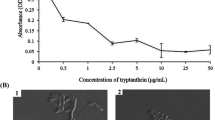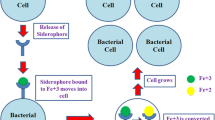Abstract
Copper causes significant damage to the integrity of many bacteria, mainly at the DNA level, through its redox states, as well as its reactive oxygen species (ROS) generating capacity at the cellular level. But whether these mechanisms also apply to Mycobacterium avium subsp. paratuberculosis (MAP) is unknown. In the present study, we have evaluated whether copper ions produce damage at the DNA level of MAP, either through their redox states or through ROS production. MAP-spiked PBS was first supplemented with different copper chelators (2) and ROS antioxidants (3), followed by treatment with copper ions at 942 ppm. MAP DNA integrity (qPCR, magnetic phage separation) was then evaluated. We found that bathocuproine (BCS), as a chelator, and D-mannitol, as an antioxidant of hydroxyl radicals, had a significant protective effect (P < 0.05) on DNA molecules, and that EDTA, as a chelator, and D-mannitol, as an antioxidant had a significant positive effect (P < 0.05) on the viability of this pathogen in contrast to the control and other chelators and anti-oxidants used. In light of the reported findings, it may be concluded that copper ions within MAP cells are directly related to MAP DNA damage.



Similar content being viewed by others
References
Steuer P, Avilez C, Tejeda C, Gonzalez N, Ramirez-Reveco A, Ulloa F, Mella A, Grant I, Collins MT, Salgado M (2018) In vitro inactivation of Mycobacterium avium subsp paratuberculosis (MAP) by use of copper ions. BMC Microbiol 18:172
Shahzadi S, Zafar N, Sharif R (2018) Antibacterial activity of metallic nanoparticles, Bacterial Pathogenesis and Antibacterial Control. IntechOpen
Salah I, Parkin IP, Allan E (2021) Copper as an antimicrobial agent: recent advances. RSC Adv 11:18179–18186
Borkow G, Gabbay J (2009) Copper, an ancient remedy returning to fight microbial, fungal and viral infections. Curr Med Chem 3:272–278
Chaterjee AK, Chakraborty R, Basu T (2014) Mechanism of antibacterial activity of copper nanoparticles. Nanotechnol 25:135101
Warnes SL, Keevil SW (2016) Lack of involvement of fenton chemistry in death of methicillin-resistant and methicillin-sensitive strains of Staphylococcus aureus and destruction of their genomes on wet or dry copper alloy surfaces. Appl Environ Microbiol 7:2132–2136
Vincent M, Duval RE, Hartemann P, Engels-Deutsch M (2017) Contact killing and antimicrobial properties of copper. J Appl Microbiol 124:1032–1046
Dalecki AG, Crawford CL, Wolschendorf F (2017) Copper and antibiotics: discovery, modes of action, and opportunities for medicinal applications. Adv Microb Physiol 70:193–260
Lemire JA, Harrison JJ, Turner RJ (2013) Antimicrobial activity of metals: mechanisms, molecular targets and applications. Nat Rev Microbiol 11(6):371–384
Singh SV, Singh AV, Kumar A, Singh PK, Deb R, Verma AM, Kumar A, Tiwari R, Chakraborty S, Dhama K (2013) Survival mechanisms of Mycobacterium avium subspecies paratuberculosis within host species and in the environment-a review. Nat Sci 5(6):710–723
Steuer P, Tejeda C, Martinez O, Ramirez-Reveco A, Gonzalez N, Grant IR, Foddai ACG, Collins MT, Salgado M (2020) Effectiveness of copper ions against Mycobacterium avium subsp. paratuberculosis and bacterial communities in naturally contaminated raw cow’s milk. J Appl Microbiol 131:146–154
Tejeda C, Steuer P, Villegas M, Reyes-Jara A, Iranzo E, Umaña R, Salgado M (2022) More insights about the efficacy of copper ion treatment on Mycobacterium avium subsp. paratuberculosis (MAP): a clue for the observed tolerance. Pathogens 11(2):272
Tejeda C, Villegas M, Steuer P, Iranzo E, Gonzalez N, Ramirez-Reveco A, Salgado M (2022) Understanding the antibacterial mechanisms of copper ion treatment on Mycobacterium avium subsp. paratuberculosis. Vet Microbiol 268:109412
Joudeh N, Saragliadis A, Schulz C, Voigt A, Almaas E, Linke D (2021) Transcriptomic response analysis of Escherichia coli to palladium stress. Front Microbiol 12:741836
Warnes SL, Keevil SW (2011) Mechanism of copper surface toxicity in vancomycin-resistant enterococci following wet or dry surface contact. Appl Environ Microbiol 77(17):6049–6059
Sroka Z, Cisowski W (2003) Hydrogen peroxide scavenging, antioxidant and anti-radical activity of some phenolic acids. Food Chem Toxicol 41:753–758
Robak J, Gryglewski R (1988) Flavonoids are scavengers of superoxide anions. Biochem Pharm 37(5):837–841
Shin SJ, Han JH, Manning EJB, Collins MT (2007) Rapid and reliable method for quantification of Mycobacterium paratuberculosis by use of the BACTEC MGIT 960 System. J Clin Microbiol 45:1941–1948
Jorhem L, Afthan G, Cumont G, Dypdahl HP, Gadd K, Havre GN, Julshamn K, Kåverud K, Lind B, Loimaranta J, Merseburg M, Olsson A, Piepponen S, Sundström B, Uppstad BJ, Waaler T, Winnerstam L (2000) Determination of metals in foods by atomic absorption spectrometry after dry ashing: NMKL1 collaborative study. J AOAC Int 83(5):1204–1211
Salgado M, Alfaro M, Salazar F, Badilla X, Troncoso E, Zambrano A, Gonzalez M, Mitchell RM, Collins MT (2015) Application of cattle slurry containing Mycobacterium avium subsp. paratuberculosis (MAP) to grassland soil and its effect on the relationship between MAP and free-living amoeba. Vet Microbiol 175:26–34
Foddai ACG, Grant IR (2020) A novel one-day phage-based test for rapid detection and enumeration of viable Mycobacterium avium subsp. paratuberculosis in cows’ milk. Appl Microbiol and Biotech 104:9399–9412
Choi O, Hu Z (2008) Size dependent and reactive oxygen species related nanosilver toxicity to nitrifying bacteria. Environ Sci Technol 42:4583–4588
May KL, Lehman KM, Mitchell AM, Grabowicz M (2019) A stress response monitoring lipoprotein trafficking to the outer membrane. mBio 10(3):e00618-19
Valko M, Morris H, Cronin MTD (2005) Metals, toxicity and oxidative stress. Curr Med Chem 12:1161–1208
Chen D, Darabedian N, Li Z, Kai T, Jiang D, Zhou F (2016) An improved bathocuproine assay for accurate valence identification and quantification of copper bound by biomolecules. Anal Biochem 497:27–35
Strausak D, Mercer JFB, Dieter HH, Stremmel W, Multhaup G (2001) Copper in disorders with neurological symptoms: Alzheimer’s, Menkes, and Wilson diseases. Brain Res Bull 55:175–185
Kostić DA, Miletić GŽ, Mitić SS, Rašić ID, Živanović VV (2007) Spectrophotometric determination of microamounts of quercetin based on its complexation with copper (II). Chem Pap 61(2):73–76
Herthnek D, Englund S, Willemsen PTJ, Bölske G (2006) Sensitive detection of Mycobacterium avium subsp. paratuberculosis in bovine semen by real-time PCR. J Appl Microbiol 100:1095–1102
Salgado M, Verdugo C, Heuer C, Castillo P, Zamorano P (2013) A novel low-cost method for Mycobacterium avium subsp. paratuberculosis DNA extraction from an automated broth culture system for a real time PCR confirmation. J Vet Sci 15:233–239
Maketon W, Zenner CZ, Ogden KL (2008) Removal efficiency and binding mechanisms of copper and copper-EDTA complexes using polyethyleneimine. Environ Sci Technol 42:2124–2129
Lam PL, Wong RM, Lam KH, Hung LK, Wong MM, Yung LH, Chui CH (2020) The role of reactive oxygen species in the biological activity of antimicrobial agents: an updated mini review. Chemico-Biol Interact 320:109023
Rocha ER, Selby T, Coleman JP, Smith CJ (1996) Oxidative stress response in an anaerobe, Bacteroides fragilis: a role for catalase in protection against hydrogen peroxide. J Bacteriol 178:6895–6903
Circu ML, Aw TY (2010) Reactive oxygen species, cellular redox systems, and apoptosis. Free Radical Biol Med 48(6):749–762
Ray PD, Huang BW, Tsuji Y (2012) Reactive oxygen species (ROS) homeostasis and redox regulation in cellular signaling. Cell Signal 24:981–990
Tkeshelashvili LK, McBride T, Spence K, Loeb LA (1990) Mutation spectrum of copper-induced DNA damage. J Biol Chem 266:6401–6406
André P, Villain F (2017) Free radical scavenging properties of mannitol and its role as a constituent of hyaluronic acid fillers: a literature review. Int J Cosmet Sci 39:355–360
Liu X, Feng Z, Harris NB, Cirillo JD, Bercovier H, Barletta RG (2001) Identification of a secreted superoxide dismutase in Mycobacterium avium ssp Paratuberculosis. FEMS Microbiol Lett 202:233–238
Granger K, Moore RJ, Davies JK, Vaughan JA, Stiles PL, Stewart DJ, Tizard MLV (2004) Recovery of Mycobacterium avium subspecies paratuberculosis from the natural host for the extraction and analysis in vivo-derived RNA. J Microbiol Methods 57:241–249
Weigoldt M, Meens J, Bange FC, Pich A, Gerlach GF, Goethe R (2013) Metabolic adaptation of Mycobacterium avium subsp. paratuberculosis to the gut enviroment. Microbiol 159:380–439
Dolan SK, Welch M (2018) The glyoxylate shunt, 60 years on. Annual Rev Microbiol 72:309–330
Acknowledgements
This work was supported by FONDECYT Grant (1201574). Carlos Tejeda was the recipient of a Doctoral Studentship from the Chilean government (CONICYT) during the present study and it was part of a Doctoral Thesis of the Universidad Austral de Chile.
Funding
This research was financed by FONDECYT Grant No. 1201574.
Author information
Authors and Affiliations
Corresponding author
Ethics declarations
Conflict of interest
The authors declare no competing interests.
Additional information
Responsible Editor: Luis Augusto Nero
Publisher's note
Springer Nature remains neutral with regard to jurisdictional claims in published maps and institutional affiliations.
Supplementary Information
Below is the link to the electronic supplementary material.
Rights and permissions
Springer Nature or its licensor (e.g. a society or other partner) holds exclusive rights to this article under a publishing agreement with the author(s) or other rightsholder(s); author self-archiving of the accepted manuscript version of this article is solely governed by the terms of such publishing agreement and applicable law.
About this article
Cite this article
Tejeda, C., Villegas, M., Steuer, P. et al. Experimental evidence of the anti-bacterial activity pathway of copper ion treatment on Mycobacterium avium subsp. paratuberculosis. Braz J Microbiol 54, 407–413 (2023). https://doi.org/10.1007/s42770-022-00897-w
Received:
Accepted:
Published:
Issue Date:
DOI: https://doi.org/10.1007/s42770-022-00897-w




